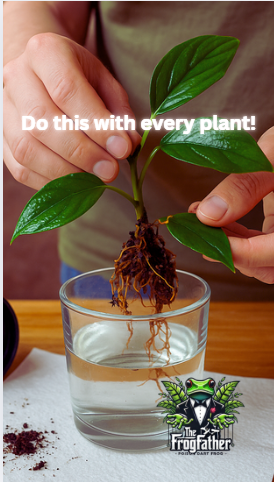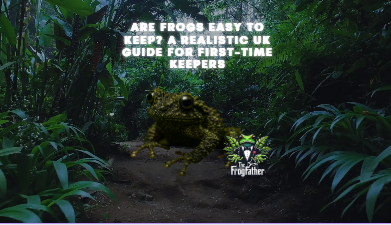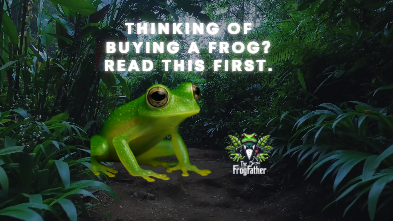When setting up a new bioactive vivarium, few steps are as overlooked — yet as important — as quarantining your plants. Whether you’re building a lush dart frog habitat or a tropical isopod enclosure, skipping this stage can invite unwanted guests like snails, slugs, mites, or fungus gnats straight into your setup.
At Frogfather, we’ve all made the same mistake once: adding a beautiful new plant straight from the shop shelf, only to find trails, eggs, or mould spreading across the substrate days later. So, here’s why quarantine matters — and how to do it right.
🐌 1. Hidden Hitchhikers Lurking in the Soil
Even plants from reputable garden centres or terrarium suppliers can carry hidden passengers. Moist soil and dense root systems are perfect for snail and slug eggs to hide. When they hatch inside your vivarium’s warm, humid conditions, you’ve got an instant infestation.
That’s where the Bioactive Snail & Slug Removal Kit comes in — designed to safely remove these pests without harming frogs or microfauna. But ideally, you’ll stop them before they ever arrive.
🪲 2. Other Common Plant Pests
Snails aren’t the only threat. Quarantine helps prevent several issues before they take hold:
- Fungus gnats – thrive in damp potting soil and can breed fast under vivarium lighting.
- Spider mites – feed on leaf tissue, especially on delicate species like Selaginella or ferns.
- Springtail overloads – occasionally plants come with an unbalanced culture that can outcompete your existing microfauna.
- Predatory beetles or small rove beetles – rare, but possible when collecting wild moss or leaf litter.
🌱 3. Giving Plants Time to Recover
Most terrarium plants, such as Selaginella erythropus and Selaginella uncinata, are grown under greenhouse or high-fertiliser conditions. When moved into your bioactive setup — with lower nutrients and different humidity — they can go into shock. A short quarantine period helps them adapt gradually before being placed into your display enclosure.
🧴 4. How to Quarantine Plants Properly
Here’s a simple step-by-step process you can use at home:
- Remove the old soil. Gently wash roots under lukewarm water to remove as much substrate as possible.
- Inspect thoroughly. Look under leaves and along the stem base for eggs, small snails, or webbing.
- Soak in mild treatment. Submerge the plant for 10–15 minutes in a natural pest rinse (you can use diluted citric acid or a plant-safe wash).
- Pot temporarily. Place in fresh, clean substrate inside a small quarantine container with ventilation holes.
- Observe for 1–2 weeks. Watch for pests or mould growth before adding to your vivarium.
💧 5. Where to Quarantine Your Plants
A simple plastic tub or spare 3D vivarium works perfectly. Add a small amount of moistened substrate and keep the container somewhere warm and bright. If you notice pests appear, isolate and treat them before reintroducing the plant to your main tank.
🧠 6. Boosting Microfauna Balance
Once your plants are pest-free, reintroduce them alongside healthy cultures of springtails and isopods. This maintains balance and prevents leftover detritus from becoming food for opportunistic pests. Tools like the Springtail Collection Riser help manage microfauna populations efficiently.
🌿 7. Long-Term Benefits
Quarantining plants may feel like an extra step, but it protects your setup’s long-term health. You’ll reduce pest outbreaks, preserve your plants, and protect your frogs or invertebrates from unnecessary stress. It’s one of the easiest habits that separates good vivarium keeping from great vivarium keeping.
✅ Final Thoughts
Think of plant quarantine as your vivarium’s “customs check.” Everything that enters your ecosystem should be inspected, cleaned, and cleared. A few extra days of patience saves weeks of frustration later.
And if any unwanted guests still slip through? The Bioactive Snail & Slug Removal Kit is ready to help. Safe, natural, and completely frog-friendly.
❓ Frequently Asked Questions
How long should I quarantine plants before adding them to a vivarium?
For most tropical plants, a quarantine period of 10–14 days is ideal. This allows time for any hidden eggs or larvae to hatch so they can be spotted and removed before plants enter your bioactive setup. During this time, monitor for snails, mites, mould, or yellowing leaves.
What’s the best way to clean plants before quarantine?
Gently remove all old soil, rinse roots under lukewarm water, and inspect each leaf for pests or eggs. Many keepers also soak plants in a diluted citric acid rinse or plant-safe wash for 10–15 minutes to eliminate hitchhikers without harming the plant.
Can I use pesticides or insecticidal soaps on vivarium plants?
It’s best to avoid chemical pesticides, especially if the plants will live in dart frog or isopod enclosures. Even small residues can harm amphibians and microfauna. Stick to natural rinses or manual removal methods instead.
Do I need to quarantine tissue-cultured plants?
Tissue-cultured plants are usually pest-free, but still benefit from a short observation period. This ensures they recover from transplant shock and adapt to your vivarium’s humidity and lighting before being introduced.
What pests should I look out for on new plants?
Common hitchhikers include snails, slugs, fungus gnats, spider mites, and springtail overloads. Check under leaves, around stem bases, and inside root balls for small white eggs or movement. If found, isolate and treat the plant before reintroducing it.
How do I remove snails or slugs from plants before planting?
Inspect plants under bright light, remove visible snails or eggs, and use a natural baiting method like the Bioactive Snail & Slug Removal Kit. It’s frog-safe, bioactive-friendly, and designed specifically for humid vivarium environments.
Can I quarantine multiple plants together?
Yes, but only if they’re from the same source. Mixing plants from different shops increases the chance of cross-contamination. Always label and track plants so you know where any potential pests originated.
Where should I keep plants during quarantine?
A small ventilated container, plastic tub, or spare 3D vivarium works perfectly. Keep it warm and humid but not soggy, with indirect light. Mist lightly every few days and check for any signs of pests or rot.
Do I still need to quarantine if the plants came from a trusted vivarium supplier?
Even specialist suppliers can have the occasional hitchhiker. Quarantining is less about distrust and more about maintaining your ecosystem’s health. It’s always safer to observe first rather than risk introducing pests to a mature bioactive tank.
Can I reuse the soil from plant pots in my vivarium?
It’s not recommended. Commercial potting soils often contain fertilisers or pest-control agents unsuitable for amphibians. Always replace it with bioactive-safe substrate or your preferred tropical soil mix.



